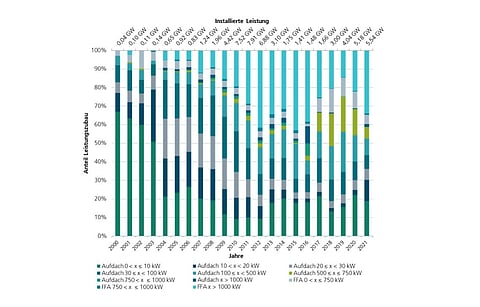

Popularity of residential and small commercial rooftop solar PV systems with up to 30 kW capacity appears to be increasing in Germany along with interest in PV home storage systems. This is the result of a short Fraunhofer ISE study analyzing installations from the year 2000 to date as covered in the national market master data register (MaStR).
Rooftop PV systems with up to 30 kW have seen their share almost double from 18.8% in 2018 to 36.2% in 2021. The analysts believe a major contributing factor to this is the elimination of the obligation to pay a levy on self-consumption for PV systems in the 10 kW to 30 kW range.
Particularly strong growth has occurred in systems within 10 kW to 20 kW range that are still used for private homes. According to Fraunhofer, in 2020 this segment accounted for only 2.7%, but in 2021 its share went up to 11.5% of the increase in capacity.
Since 2020, the importance of ground mounted systems was on the rise again as these accounted for 39.7% of newly installed capacity in 2021.
Under the country's Renewable Sources Act (EEG), in 2021 solar PV systems of up to 30 kW could only feed a maximum of 70% of their power into the grid as these did not have a remote controlled feed-in management system. "This limitation, which applies primarily to systems up to 30 kW, is applicable to new systems (less than 25 kW) from Jan.1 according to the EEG amendment. It is no longer relevant in 2023," point out the analysts.
There is a steady rise in systems with east-west orientation since 2021 while the share of south, south-west and south-east oriented systems has been coming down since 2013.
"This is an encouraging development, as this orientation is very beneficial to the grid and contributes to the stabilization of the photovoltaic output throughout the day," explained author of the study Dominik Peper. The angle of inclination for 57.1% of the newly installed systems was between 20º to 40º in 2021, systems with flat angles of inclination made up 19% of the capacity.
Building integrated PV (BIPV) installations are yet to take off as their total share last year was a mere 0.1%.
Fraunhofer ISE also sees a preference for battery energy storage systems in Germany which at the end of 2021 was a total of 326,048 systems installed with a combined capacity of 3,521 MWh. Of these, more than 1/3rd came online in 2021. In terms of system capacity, installations within a 5 kWh and 10 kWh range are highly preferred. System sizes between 10 kWh to 20 kWh accounted for 32.8% of new construction in 2021. At the end of 2021, 85 large-scale storage systems with a capacity of more than 1,000 MWh were installed
The researchers attribute this interest to falling prices for battery storage, increase in electricity prices and desire for self-sufficiency among system operators.
Another trend the numbers show is the geographical distribution of rooftop PV growing in Germany's most populated stated North Rhine-Westphalia as well as Lower Saxony and Rhineland-Palatinate in 2021 among other regions, whereas previously the southern states of Baden-Württemberg and Bavaria ruled the space.
.png?w=50&fm=png)